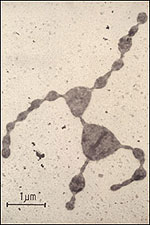The search for life: Astrobiology
By Monica Grady
The limits to life
The 'biological envelope' describes the limits within which life can survive, grow and evolve. These limits are based on the physical properties of the compounds that make up organisms. In the time between the emergence of life and the present day, microbes have colonised every niche in which it is possible for life to survive. Those that exist in the most extreme physical environments are known as the extremophiles. The parameters of the biological envelope guide the search for life elsewhere in the solar system.
Living organisms are classified into one of three domains, or superkingdoms: Bacteria, Archaea and Eukarya. The first two domains consist of groups of relatively simple organisms. The Eukarya are more evolved, complex organisms, made up of cells containing a nucleus. All living organisms require water to survive. Apart from that, the most rigorous constraints are the ambient temperature and the salinity and acidity of water. Many extremophiles belong to the Archaea domain, although there are also significant families in the Bacteria and Eukarya domains.
In this section we will look at the different types of extremophiles and describes the environments in which they live.
Thermophiles and hyperthermophiles

A hyperthermophilic archaea that lives in hydrothermal vents at temperatures around 100°C. (Image: Professor K Stetter, University of Regensberg, Germany)
These microbes are found in hot water environments all over the world. Thermophiles flourish at temperatures from 50-70°C whilst hyperthermophiles prefer temperatures as high as 80-110°C. Both types of organism are found on the surface in hot springs and geysers in volcanically active regions, fumaroles and solfataras (places where hot gases, rather than liquids, are emitted from vents). Both can also be found at depth within sediments and oil reserves while hypothermophilic archaea occur near hydrothermal vents and undersea volcanoes.
Psychrophiles
These are cold-loving organisms that flourish at around 0°C. The limit for growth is the freezing point of water, which means that in briny solutions, these micro-organisms can survive at around -2°C. Psychrophilic bacteria and archaea have been identified at the ocean floor, close to the base of hydrothermal vents and within ice-cores drilled from deep within the Antarctic plateau. Other psychrophiles inhabit the Dry Valleys of Antarctica, within sandstones and quartzites. These microbes are of great interest because they could act as a model for organisms that might survive in similar circumstances within the frozen sub-surface layer of Martian soils.
Acidophiles and Alkalophiles
Acidophiles are frequently sulphur-loving thermophilic or hyperthermophilic organisms. The most widespread acidophiles are archaea and bacteria species that are found around hydrothermal vents and solfataras, oil reservoirs and spoil heaps. They metabolise by turning sulphur into sulphuric acid and survive down to pH values of around 0-0.7. The sulphur-rich hot springs and geysers of Jupiter's satellite Io would make an intriguing location in which to search for acidophilic bacteria.
In contrast, alkalophiles thrive at pH values up to 12.5. In the African soda lake, Lake Nakuru, a colourful flamingo population feasts on Spirulina, an alkalphilic bacterium that flourishes in its waters.
Halophiles
These species are adapted to survive in liquids with high salt concentrations (up to 37.5 percent) and some organisms within this group are also alkalophiles--the alkaline soda in Lake Nakuru is also hypersaline and supports a rich diversity of bacteria and archaea. Within the solar system, halite (a form of salt) has been found in Martian meteorites, suggesting that brine pools must have been relatively common on the surface of Mars. It has been hypothesised that rapid desiccation of the surface after loss of its atmosphere may have rendered Mars rich in regions of high salt concentration, in which halophilic micro-organisms might have flourished.